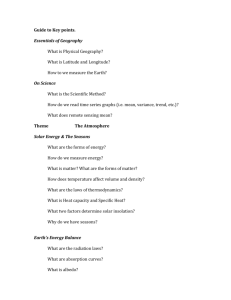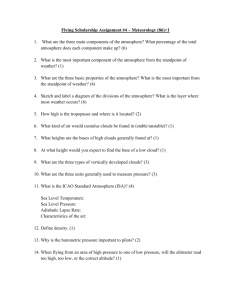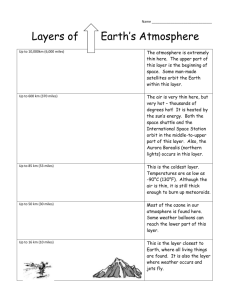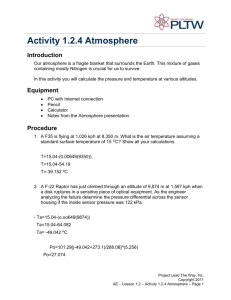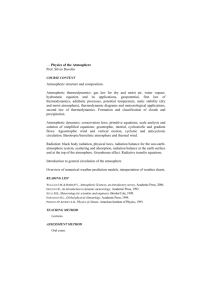Introduction to the Atmosphere
advertisement
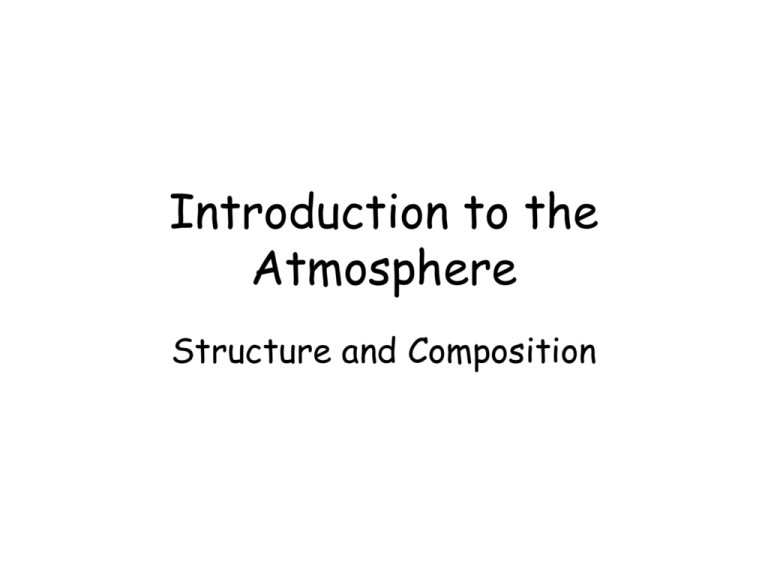
Introduction to the Atmosphere Structure and Composition Atmosphere (air) is: • a mixture of gases held to Earth by gravity. • Earth’s primary means of transporting energy and moisture over its surface. • an insulator and shield (“ editing the sun”). • relatively thin Earth (including its atmosphere) has a radius of about 6500 km. The atmosphere is only about 100 km thick—less than 2% of the Earth’s thickness. • Despite its relative shallowness, the atmosphere contains considerable mass: 5.14 X 10E15 kg • that’s a mass equivalent to 5.65 billion million tons, the amount of water that would fill a lake the size of California to a depth of 13 km (7.7 miles) Thermopause: the top of Earth’s atmosphere @ 480 km (or 300 miles) above the surface Exosphere: H and He atoms weakly bound by gravity up to about 32,000 km (or 20,000 miles) from the surface Atmospheric density decreases with altitude… 1. About 97% of the atmosphere is within 30 km (18 miles) of the surface. 2. 75% is compressed below 10,700 m or 35,100 feet (~7 miles)…which is to say, within the troposphere Atmospheric density decreases with altitude… Density: the amount of mass of a substance (expressed in kilograms) contained in a unit of volume (1 cubic meter) Atmospheric density decreases with altitude… In gases, individual molecules have no attachment to each other and move about randomly. So…there is no definite limit to the amount of mass that can exist in a given volume—molecules can always be added to or removed from the volume… Result change in density Atmospheric density decreases with altitude… Mean free path the average distance a molecule travels before colliding with another Near Earth’s surfacemean free path is a mere 0.0001 mm 150 km (93 miles) above sea level (i.e., in the thermosphere) a molecule travels about 10 m before colliding with another Atmospheric/Air Pressure • Def. the weight (or force exerted over a unit area) of atmosphere • That is, under the influence of gravity, air is compressed & thus denser (& to you, heavier) at the Earth’s surface • At sea level average air pressure is: 1 kg/cm2 (14.7 lbs./in2 ) A Profile of the Atmosphere: Three Criteria • 1. Composition • 2. Temperature (also pressure) • 3. Function Composition: Heterosphere & Homosphere • Heterosphere (ca. 80 km to 480 km OR 50 miles to 300 miles) • Not evenly mixed • Less than 0.001% of the atmosphere’s mass Composition: Heterosphere & Homosphere • Homosphere (surface to ca. 80 km or 50 miles) • Nearly uniform blend of gases throughout… • Exceptions? • *Nitrogen, Oxygen (a byproduct of?), *Argon (radioactive decay of a form of potassium), Carbon dioxide (has been increasing over last 200 years) Temperature Troposphere from ground to 8 to 16 km Stratosphere from 8 or 16 km to about 50 km Mesosphere from 50 to 80 km Thermosphere from 80 to 480 km (high temperature but low heat) Lapse Rates Troposphere heated by longwave radiation from Earth’s surface- further from surface colder temp Lapse rate = rate of change Normal lapse rate- average rate of temp change 6.4 °C/1000 m (ascent) (3.5 °F/1000 ft) Environmental lapse rate- actual change in temp for given location. You are going hiking.. Your hike begins at 6000 feet and the temperature is 80 degrees Fahrenheit. The summit of this mountain is 12,100 feet. Using the normal lapse rate, predict the temperature at the summit. What is the change in temperature on your hike? 1. Find change in elevation (12,100-6000 = 6100 feet) 2. Divide the change in elevation by the distance portion of the lapse rate (6100 ft /1000 ft= 6.1) 3. Multiply the result by the temperature portion of the lapse rate (6.1 x 3.5 degrees F = 21.35 degrees F) 4. Subtract result from original temperature (80 – 21.35 = 58.65 degrees F) Temperature inversion 2. Ozonosphere- within stratosphere, Composed of > reactive oxygen molecules (O3), Filters solar radiation, absorbing UV light Has been stable several 100 million years, now greatly variable The Ozone Layer Why doesn’t Ozone continually build up? 1. OZONE (O3) recombines w/ atomic oxygen to form O2 + + 2. OZONE (O3) absorption of UV radiation leads to break down into atomic & molecular oxygen UV radiation + Ionosphere: Ion = electrically charged particle formed when electrically neutral atoms or molecules lose or gain one or more electrons **due to bombardment by solar energy LOSE electrons Aurora borealis and Aurora australis Subatomic particles captured by Earth’s magnetic field Captured energy excites gases of atmosphere…meaning their electrons jump to greater orbital distances from their nuclei When electrons fall back to lower orbital, radiation is emitted.

